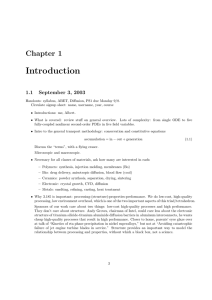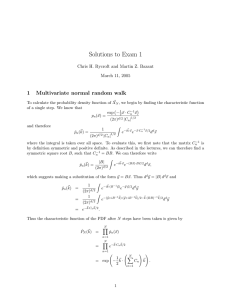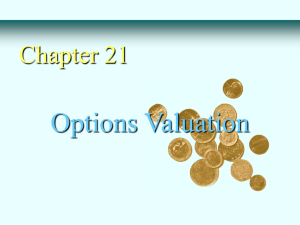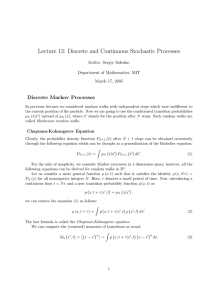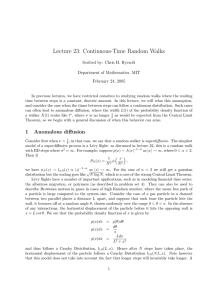Lecture 12: Black-Scholes-Merton and Beyond Dynamic Hedging
advertisement
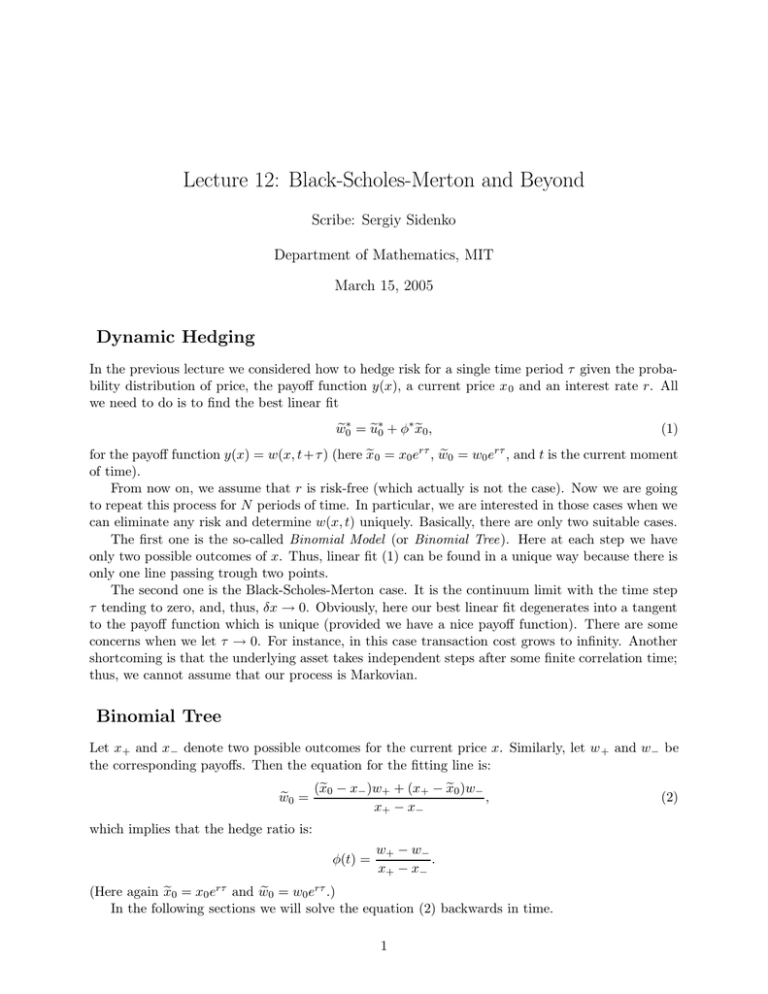
Lecture 12: Black-Scholes-Merton and Beyond Scribe: Sergiy Sidenko Department of Mathematics, MIT March 15, 2005 Dynamic Hedging In the previous lecture we considered how to hedge risk for a single time period δ given the proba­ bility distribution of price, the payoff function y(x), a current price x 0 and an interest rate r. All we need to do is to find the best linear fit �0 , w �0� = u �0� + ∂� x (1) for the payoff function y(x) = w(x, t+ δ ) (here x �0 = x0 er� , w �0 = w0 er� , and t is the current moment of time). From now on, we assume that r is risk-free (which actually is not the case). Now we are going to repeat this process for N periods of time. In particular, we are interested in those cases when we can eliminate any risk and determine w(x, t) uniquely. Basically, there are only two suitable cases. The first one is the so-called Binomial Model (or Binomial Tree). Here at each step we have only two possible outcomes of x. Thus, linear fit (1) can be found in a unique way because there is only one line passing trough two points. The second one is the Black-Scholes-Merton case. It is the continuum limit with the time step δ tending to zero, and, thus, �x � 0. Obviously, here our best linear fit degenerates into a tangent to the payoff function which is unique (provided we have a nice payoff function). There are some concerns when we let δ � 0. For instance, in this case transaction cost grows to infinity. Another shortcoming is that the underlying asset takes independent steps after some finite correlation time; thus, we cannot assume that our process is Markovian. Binomial Tree Let x+ and x− denote two possible outcomes for the current price x. Similarly, let w + and w− be the corresponding payoffs. Then the equation for the fitting line is: w �0 = which implies that the hedge ratio is: (� x0 − x− )w+ + (x+ − x �0 )w− , x+ − x − ∂(t) = w+ − w − . x+ − x − (Here again x �0 = x0 er� and w �0 = w0 er� .) In the following sections we will solve the equation (2) backwards in time. 1 (2) 2 M. Z. Bazant – 18.366 Random Walks and Diffusion – Lecture 12 x x0 t 1 2 3 4 5 6 7 Figure 1: Binomial Tree Continuum Limit Normal (Additive) Stochastic Process for xt Let us consider the process where x± = x0 ± a. Assuming that r = 0, we can rewrite the equation (2) as follows: 1 (3) w(x, t) = (w(x + a, t + δ ) + w(x − a, t + δ )) . 2 It is important to note that although the probabilities of x ± could be different, we would still have the same equation (3). Now we can consider the process as a Bernoulli random walk with probabilities 1/2 in backward time. Transforming (3), we get: 1 (w(x + a, t + δ ) − 2w(x, t + δ ) + w(x − a, t + δ )) 2 � � � �w 1 �w a � 2 w + ... w(x, t + δ ) − δ + . . . − w(x, t + δ ) = w(x, t + δ ) + a + �t 2 �x 2 �x2 � �w a � 2 w −2w(x, t + δ ) + w(x, t + δ ) − a + + ... . �x 2 �x2 w(x, t) − w(x, t + δ ) = Here all partial derivatives are evaluated at the point (x, t + δ ). Now, omitting all higher-order terms (assuming that δ � 0 and a � 0), we obtain the diffusion equation: �2w �w =D 2, (4) − �t �x M. Z. Bazant – 18.366 Random Walks and Diffusion – Lecture 12 where D= 3 a2 2δ is a diffusion coefficient. Thus, we see that the option price ‘diffuses’ in backward time from the known payoff at t = T . Lognormal (Multiplicative) Process for xt � Here we will consider the binomial model with x ± = xeµ±� � . Expanding these outcomes we have: � � � π2 δ x± = x 1 + µδ ± π δ + + ... 2 � � = x 1 + µ̄δ ± π δ + . . . , 2 where µ ¯ = µ + �2 is a noise induced drift. Then the relative change of x is: � �x = � (log x) = µ̄δ ± π δ . x �0 and x �0 can be represented as follows: The quantities w w �0 = er� w(x, t) = (1 + rδ )w(x, t), x �0 = er� x0 = (1 + rδ )x0 . Now we apply the binomial model for each time step δ : (x+ − x− )w �0 = (� x0 − x− )w+ + (x+ − x �0 )w− Substituting w �0 , x �0 and x± : � � � 2π δ x (1 + rδ )w(x, t) = (r − µ̄)δ (w+ − w− ) + π δ x(w+ + w− ), where � � � 1 2 2 � 2 w �� �w �� + .... π δ x + w± = w(x± , t + δ ) = w(x, t + δ ) + (¯ µδ ± π δ )x �x �(x,t+� ) 2 �x2 �(x,t+� ) Thus, and This gives us: � � �w �� w+ − w− = 2π δ x + ... �x �(x,t+� ) � � 2 � �w �� 2 2 � w� + π δx + .... µδ x w+ + w− = 2w(x, t + δ ) + 2¯ �x �(x,t+� ) �x2 �(x,t+� ) � � � �w �� π 2 2 � 2 w �� �w �� + δx , (1 + rδ )w(x, t) = (r − µ)δ ¯ x + w(x, t + δ ) + µδ ¯ x �x �(x,t+� ) �x �(x,t+� ) 2 �x2 �(x,t+� ) M. Z. Bazant – 18.366 Random Walks and Diffusion – Lecture 12 4 and the Black-Scholes miracle occurs: the drift (or expected return in x t ) drops out. However, µ ¯ is present in higher-order terms. Now, simplifying the obtained equation, we get: � � w(x, t) − w(x, t + δ ) π 2 x2 � 2 w �� �w �� + + rw(x, t) = rx . δ �x �(x,t+� ) 2 �x2 �(x,t+� ) Taking the limit with δ � 0, we obtain the Black-Scholes equation: �w �w π 2 2 � 2 w + rx + x = rw. �t �x 2 �x2 (5) Recall that we are assuming that w(x, t) is independent of measure of risk expected return µ and r is a risk-free rate. Risk-Neutral Valuation Let us eliminate dimensions from the Black-Scholes equation. Namely, let us introduce the following variables: T −t , T x x̄ = log , k w̄ = er(T −t) w, t¯ = r̄ = rT, π̄ 2 = π 2 T. Then, the partial derivatives have to be: � �x ¯ � �t̄ � , �x 1 � = − . T �t = x Now, equation (5) becomes: �w ¯ = �t̄ � r̄ − π ¯2 2 � ¯2 �2w ¯ �w ¯ π + . �x ¯ 2 � x ¯2 ¯ x, 0) = �(¯ The Green function (solution for the initial condition w(¯ x)) for (6) is: � � 2 � ¯ + t̄(¯ r−π ¯ 2 /2) x 1 ¯ =� , Ḡ(¯ x, t) exp − π 2 t¯ 2¯ π 2 t̄ 2�¯ (6) (7) ¯r−π ¯ Having this, we can write which is a normal distribution with mean t(¯ ¯ 2 /2) and variance π ¯ 2 t. a solution with the arbitrary initial condition y(¯ ¯ x) as a convolution: � ¯ φ ȳ (¯ ¯ = G w(¯ ¯ x, t) x, t̄), M. Z. Bazant – 18.366 Random Walks and Diffusion – Lecture 12 5 which can be simplified as follows: ¯ = �y(¯ ¯ √G¯ . w(¯ ¯ x, t) ¯ x, t) Putting the dimensions back, we have the Green function for the Black-Scholes equation (5) G(x, t) = er(t−T ) L(x, t), where L(x, t) is a lognormal density with expected return r and volatility π 2 which solves the following SDE for a lognormal process from t to T : dx = r x dt + π x dz (Recall that in lecture 10 we showed that the mean of such a lognormal random variable with 2 expected rate of return m and volatility π has expected value x o e(m+� /2)(T −t) , and here m = r − π 2 /2.) In terms of the Green function, the general solution can be written as an expectation of the payoff with respect to the lognormal process w(x, t) = er(t−T ) �y(x)√. This appears to be the same as Bachelier’s fair price, equal to the expected payoff (discounted at the risk-free interest rate), except for one subtle difference: The mean rate of return µ in the lognormal process for the underlying asset has been replaced by r, the risk-free rate! This is again the “Black-Scholes mirable” caused by the hedging procedure, neglected by Bachelier, which removes any dependence on the mean return relative to the risk-free rate. Rather than solving the Black-Scholes PDE, therefore, we can instead applying the simple Bachelier “fair-game” principle, replacing µ with r. This procedure of risk neutral valuation is a powerful and widely used tool in options pricing and hedging. In reality, however, a perfect hedge is not possible, and risk neutral valuation is only a first approximation. The presence of residual risk can be treated by various methods such as the Bouchaud-Sornette theory introduced in the previous lecture. In the continuum limit, this leads to perturbations of the Black-Scholes equation and corrections to risk-neutal valuation. For more details, see the solutions to Problem Set 3 and the final project of Ken Gosier from 2001, Derivatives Pricing and Hedging with Residual Risk, both available online.
